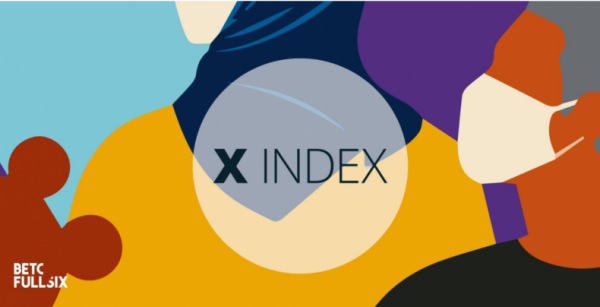EFFICIENCY AND EMOTION THE MOST IMPORTANT FACTORS IN GOOD CX, SAYS HAVAS STUDY
- The X Index, Havas CX’s barometer of customer experience efficiency, surveyed 28,000 consumers across five markets, scoring 250+ brands against 40 criteria
- It sheds light on the dual, but contrasting, needs of consumers – who demand an almost Darwinist functional efficiency while simultaneously seeking an emotional connection from the brands they interact with (and buy from)
- It also unearths a clear divide in consumer expectations of ‘bricks and clicks’ brands versus digital pure players – which are missing the opportunity to connect on an emotional level

9th Mars 2021
Efficiency and emotion are the most important factors when it comes to good CX, says a new Havas study into consumer attitudes towards customer experience. The X Index, which surveyed 28,000 consumers across five markets, found that of the 40 criteria analysed, ‘the customer journey was simple’ and ‘the customer journey was pleasant’ scored the highest – above other factors including brand loyalty, customer service and price.
In total, 250 brands – including both ‘bricks and clicks’ brands (bricks-and-mortar retailers that have implemented digital transformation programmes) and pure players (digital natives, online-only) – were rated across each criterion according to consumers’ perception of their importance to the overall customer experience.
For ‘bricks and clicks’ brands, the pleasantness of the experience ranked as either the most or second-most important factor in all five markets surveyed – the UK, the US and China, where it took top spot, plus India and France – with simplicity and seamlessness also ranking highly. For pure players, simplicity was the most important single factor in three of the five markets (the UK, France and China). While pleasantness of experience did also emerge as a discerning factor for pure players, it was considerably less pronounced than it was for ‘bricks and clicks’ brands.
Overall, the study – conducted by Havas CX in partnership with research institute OpinionWay – shines a light on the dual but contrasting needs of consumers who demand an almost Darwinist functional efficiency while simultaneously seeking an emotional connection from the brands they interact with (and buy from).
It also uncovers a divide in consumer expectations of ‘bricks and clicks’ brands versus digital pure players – with emotional needs ranking higher for the former, functionality for the latter. This underlines a clear opportunity for pure players – with functionality very much a given, the emotional can represent a clear differentiating factor.
In total, 40 criteria were analysed across the key components of a customer journey: brand (i.e. ‘I completely trust the brand’, ‘I am loyal to the brand’), relationship (i.e. ‘quality of customer service’, ‘website and mobile app content is customised to customer needs’), purchase (i.e. ‘was seamless’, ‘was not intrusive’), product (i.e. ‘satisfaction with the quality of the services/products’, ‘satisfaction with the price of the services/products’) and, in light of the exceptional circumstances of the pandemic, response to COVID-19 (i.e. ‘adapted its shopping experience well’, ‘maintained relevant and responsible communication’).
While the importance consumers place on efficiency and emotion stands out, effective CX is driven by a unique combination of these factors in each market. Havas CX has analysed this data to identify four key overarching principles of best-in-class customer experience in 2021:
#1 PUT EFFICIENCY AT THE CORE:
Consumers have gone massively digital in their shopping this year, a trend exacerbated by the pandemic. This shift has made them even more sensitive to the efficiency of the experience, and a simple and seamless purchase journey makes up a substantial portion of the CX scores in each of the five countries – including a huge 31% of total score for digital pure players in the UK.
#2 ALIGN YOUR PURPOSE AND ACTIONS:
CX is ultimately a matter of perception – or what a consumer is promised versus what they experience in practice. The fact that ‘the brand keeps its commitments’ ranks in the three most important criteria in two out of five markets underscores the importance of reliability and not overpromising/underdelivering. Likewise, ‘I completely trust the brand’ made a marked contribution to CX scores in three out of five markets, with a high of 25% for bricks and clicks retailers in France. At a time when trust in institutions and political figures is low, brands can stand out by transparently and consistently communicating their values—and backing those words with action.
#3 REINVENT RELATIONSHIPS:
Underlining the shift from physical to digital commerce, ‘the attention and efficiency of staff’ saw its contribution to the X Index reduced by more than half in France and to zero in China and the US. With sales staff largely out of the picture, personalisation – which accounts for a significant contribution to total X Index score in each of the five markets, including a significant 30% for UK ‘bricks and clicks’ retailers, must take different forms.
#4 FIGHT AGAINST DIGITAL SAMENESS:
Delivering on effectiveness alone is not enough to make a lasting difference – and this year, the ability to bring to life signature moments and forge an emotional connection created value for brands. Indeed, ‘the purchase journey was pleasant’ is a major contributor to the X Index across all markets and was ranked the single most important criteria for consumers in three of the five markets. Likewise, variety and exclusivity set brands apart – with ‘offered me products/services I couldn’t find anywhere else’ the single most important criteria for consumers in China.
Sébastien Houdusse, Chief Strategy Officer of Havas CX agency BETC Fullsix, says: “The X Index demonstrates a clear tension in customer experience between efficiency and emotion – with these two contrasting factors sought by consumers more than any other. But with functionality very much ‘table stakes’ in 2021, it’s the emotional through which brands can really stand out from the crowd. This is particularly the case for pure players, operating in a world in which the relentless pursuit of optimum functionality has seen it cease to be much of a meaningful differentiator between competing brands.”
NOTES TO EDITORS
About the X Index: Created in partnership with research institute OpinionWay in 2018, the Havas X Index proprietary tool serves as a global barometer to measure and maximize customer experience.
In 2020, Havas deployed the X Index across five countries—China, France, India, the United Kingdom, and the United States—surveying 28,000 adults about more than 250 brands (approximately 50 in each market). These brands operate in a variety of industries, from fast food and fashion to transportation, technology, and finance, and include both ‘bricks and clicks’ (brick-and-mortar brands that have gone through the digital transformation) and ‘pure players’ (online only).
Havas’ research team sought to analyze each brand across 40 criteria, with each respondent responsible for rating two brands with which they had at least one shopping experience during the previous 12 months. Each measure relates to one of the essential steps of any customer journey: the brand itself, the relationship between the customer and brand (both push and pull), the purchase journey, and the experience with the product/service. In light of this year’s exceptional circumstances, the agency added a fifth category for 2020: how the brand has responded to the COVID-19 crisis. Finally, we queried each respondent about their overall satisfaction with the customer experience.
The Havas CX data department designed the X Index by applying a linear regression model. It used univariate correlation analysis to obtain a more robust model: • Pre-selecting only criteria with the best correlations; • Checking that there were no autocorrelations between the different criteria; & • Using a stepwise approach to select the most relevant criteria in order to build the final X Index model.
This data model determines what are the most discriminating criteria that define the efficiency of customer experience among the 40 items that were put in the model at the start. This model builds an unbiased approach to CX efficiency and provides the means to compare what makes a good customer experience for bricks and clicks brands and pure players, and also enables comparison of results between countries.
About Havas CX: Havas CX is as an international network committed to delivering meaningful brand experiences across the entire customer journey. It brings together more than 1,500 people in 25 Havas Villages around the world with key hubs in London, Paris, New York and Mumbai.
The network includes 20 of Havas’ global agency groups including ekino (digital transformation), BETC FullSix (customer experience), Havas CX helia (customer engagement) and award-winning leaders in their markets including Plastic Havas, Langoor, Boondoggle, Gate One, Think Design, Host/Havas, Project House and Intellignos.
Havas CX is a powerhouse of experts in every area of digital transformation and design, customer experience and customer engagement, eCommerce and much more.

